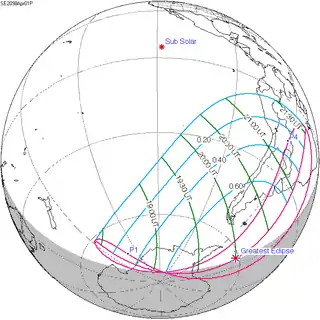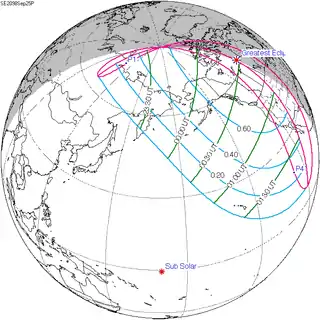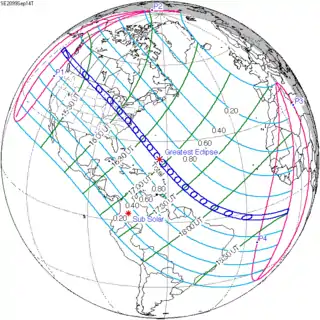| Solar eclipse of April 1, 2098 | |
|---|---|
 Map | |
| Type of eclipse | |
| Nature | Partial |
| Gamma | −1.1005 |
| Magnitude | 0.7984 |
| Maximum eclipse | |
| Coordinates | 61°00′S 38°06′W / 61°S 38.1°W |
| Times (UTC) | |
| Greatest eclipse | 20:02:31 |
| References | |
| Saros | 121 (65 of 71) |
| Catalog # (SE5000) | 9728 |
A partial solar eclipse will occur on Tuesday, April 1, 2098. A solar eclipse occurs when the Moon passes between Earth and the Sun, thereby totally or partly obscuring the image of the Sun for a viewer on Earth. A partial solar eclipse occurs in the polar regions of the Earth when the center of the Moon's shadow misses the Earth.
Related eclipses
Solar eclipses 2098–2100
This eclipse is a member of a semester series. An eclipse in a semester series of solar eclipses repeats approximately every 177 days and 4 hours (a semester) at alternating nodes of the Moon's orbit.[1]
| Solar eclipses 2098–2100 | |||||
|---|---|---|---|---|---|
| 121 | April 1, 2098 Partial |
126 | September 25, 2098 Partial | ||
| 131 | March 21, 2099 Annular |
136 | September 14, 2099 Total | ||
| 141 | March 10, 2100 Annular |
146 | September 4, 2100 Total | ||
References
- ↑ van Gent, R.H. "Solar- and Lunar-Eclipse Predictions from Antiquity to the Present". A Catalogue of Eclipse Cycles. Utrecht University. Retrieved 6 October 2018.
External links
- Earth visibility chart and eclipse statistics Eclipse Predictions by Fred Espenak, NASA/GSFC
This article is issued from Wikipedia. The text is licensed under Creative Commons - Attribution - Sharealike. Additional terms may apply for the media files.
.jpg.webp)

